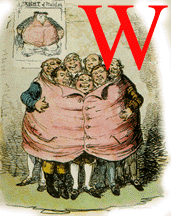. . . it is significant that the best work in fiction from the time of Fielding and Smollett until that of Jane Austen was done by men and women who were generally not professional writers or, if they were, were far from thinking of themselves primarily as novelists.
An instance is Oliver Goldsmith, whose novel The Vicar of Wakefield, . . . has proved by far the most popular eighteenth-century novel apart from those of the Big Four [Richardson, Fielding, Defoe, and Sterne]. Its popularity, indeed, has been quite disproportionate to its achievement as a novel, and much of it has undoubtedly been due to its 'niceness', which allowed adults to put in the hands of young people when Tom Jones was considered improper. —Walter Allen, The English Novel, p. 81.

hen the future author was two years old, his father, Charles, became the rector of the parish of Kilkenny West in County Westmeath. The family moved to the parsonage at Lissoy, between Athlone and Ballymahon, where they until his father's death in 1747. This ecclesiastical family background is reflected in his sentimental novella The Vicar of Wakefield.
Despite his prolific career as a writer in many different genres, Goldsmith never enjoyed the celebrity of his friend Dr. Johnson, whose name after 1756 acquired that status of household word as The Great Lexicographer. Had Goldsmith not given his only novel to Johnson to review, it might never have been published. But Goldsmith trusted Johnson's literary instincts, and allowed him to present the manuscript to bookseller and publisher Francis Newberry. Recalls Johnson of the publication circumstances,
I received one morning a message from poor Goldsmith that he was in great distress, and, as it was not in his power to come to me, begging that I would come to him as soon as possible. I sent him a guinea, and promised to come to him directly. I accordingly went as soon as I was dressed, and found that his landlady had arrested him for his rent, at which he was in a violent passion: I perceived that he had already changed my guinea, and had a bottle of Madeira and a glass before him. I put the cork into the bottle, desired he would be calm, and began to talk to him of the means by which he might be extricated. He then told me he had a novel ready for the press, which he produced to me. I looked into it and saw its merit; told the landlady I should soon return; and, having gone to a bookseller, sold it for sixty pound. I brought Goldsmith the money, and he discharged his rent, not without rating his landlady in a high tone for having used him so ill. [Boswell's Life of Johnson]
Walter Allen in The English Novel is somewhat dismissive of the slender novel, which he feels is undeserving of its fame and influence among the Victorians:
As a novel, its faults are gross. The plot is absurd, and the deus ex machina, Mr. Burchell (or Sir William Thornhill) is quite incredible. The Vicar of Wakefield survive almost in spite of Goldsmith's intentions. We read it as a domestic idyll, and especially for the character of Dr. Primrose, that unworldly clergyman who in so many ways is a softened, sweetened, more respectable Parson Adams [from Fielding's Joseph Andrews. [81-82]

he novel can be regarded as a fictitious memoir, as it is told by the vicar himself in retrospective, first-person narrative. The subtitle points to this aspect of the story: The Vicar of Wakefield – A Tale, Supposed to be written by Himself (1766). The novel has since been illustrated by Thomas Stothard (1755-1834), George Cruikshank (1792-1878), and Arthur Rackham (1867-1939) for the 1929 edition. Written in 1761-62 and published in 1766, it was one of the most popular and widely read eighteenth-century novels among Victorians. Books of literary history such as The New Cambridge Bibliography of English Literature (CBEL)often describe The Vicar of Wakefield as a sentimental novel in that it displays the protagonist's unshakable belief in the innate goodness of humanity, despite considerable evidence to the contrary. However, one may also read Goldsmith's intention as "anti-sentimental" and the novel as a satire on the popular sentimental novel and its values, as the vicar's values are apparently not compatible with his surviving inthe real,sinful world as epitomized by Squire Thornhill, the story's villain and Dr. Primrose's nemesis. Only with the assistance of the novel's Truewit, Sir William Thornhill, does the Vicar extricate himself from his financial and familial difficulties. Moreover, the pious 18th c. reader would probably have drawn an analogy between the Reverend Mr. Primrose's sufferingsand those of the Old Testament'sJob, a morally upright man whose virtue is tested by Providence.This biblical analogue is particularly relevant to the question of why evil exists.
But this is not quite how Goldsmith meant us to see his novel. In essential content it is obsessed with the same problem as are those of the greater novelists: the problem of arbitrary, irresponsible power. The abduction of Olivia by Harry Thornhill, the young squire, might have occurred in Richardson, Fielding, or Smollett, and Dr. Primrose's experiences in jail are likewise from the common fund of experience which went to the making of the eighteenth-century novel at its greatest. And Dr. Primrose was meant to be a figure of satire, almost a butt, a specimen of foolish optimism, of benevolence that did not know the world. Wisdom is represented by Burchell, whose job it is to save Primrose and his family from the consequences of the vicar's folly. But Goldsmith of all writers was the least cut out to be realistic novelist, and what he achieved was something from what he intended; instead of the near tragedy of a man who brought himself and his family to ruin he produced something very much like a fairy-tale, an idealized picture of rural picture of rural life, with a delightful Quixotic comic character at the centre and with Burchell as an awkward eighteenth-century good fairy to contrive a happy ending. [82]
Related Material
- Illustrations and Illustrated Editions of The Vicar of Wakefield
- Biographical Notes on Oliver Goldsmith (1707-54): Dramatist, Historian, Poet, and Novelist
Bibliography
Allen, Walter. 2. "The Eighteenth Century." The English Novel. Harmondsworth: Penguin, 1957. Pp. 43-102.
Benét's Reader's Encyclopedia. Third Edition. New York: Harper and Row, 1987.
Boswell, James. Boswell'sLifeofSamuel Johnson, LL. D. Comprehending an Account of his Studies and Numerous Works. Ed. Percy Fitzgerald.London:T. Cadell and W. Davies, 1811.5 vols.
Hartnoll, Phyllis, ed. The Oxford Companion to the Theatre. Oxford and New York: Oxford U. P., 1987.
Last modified 19 April 2018